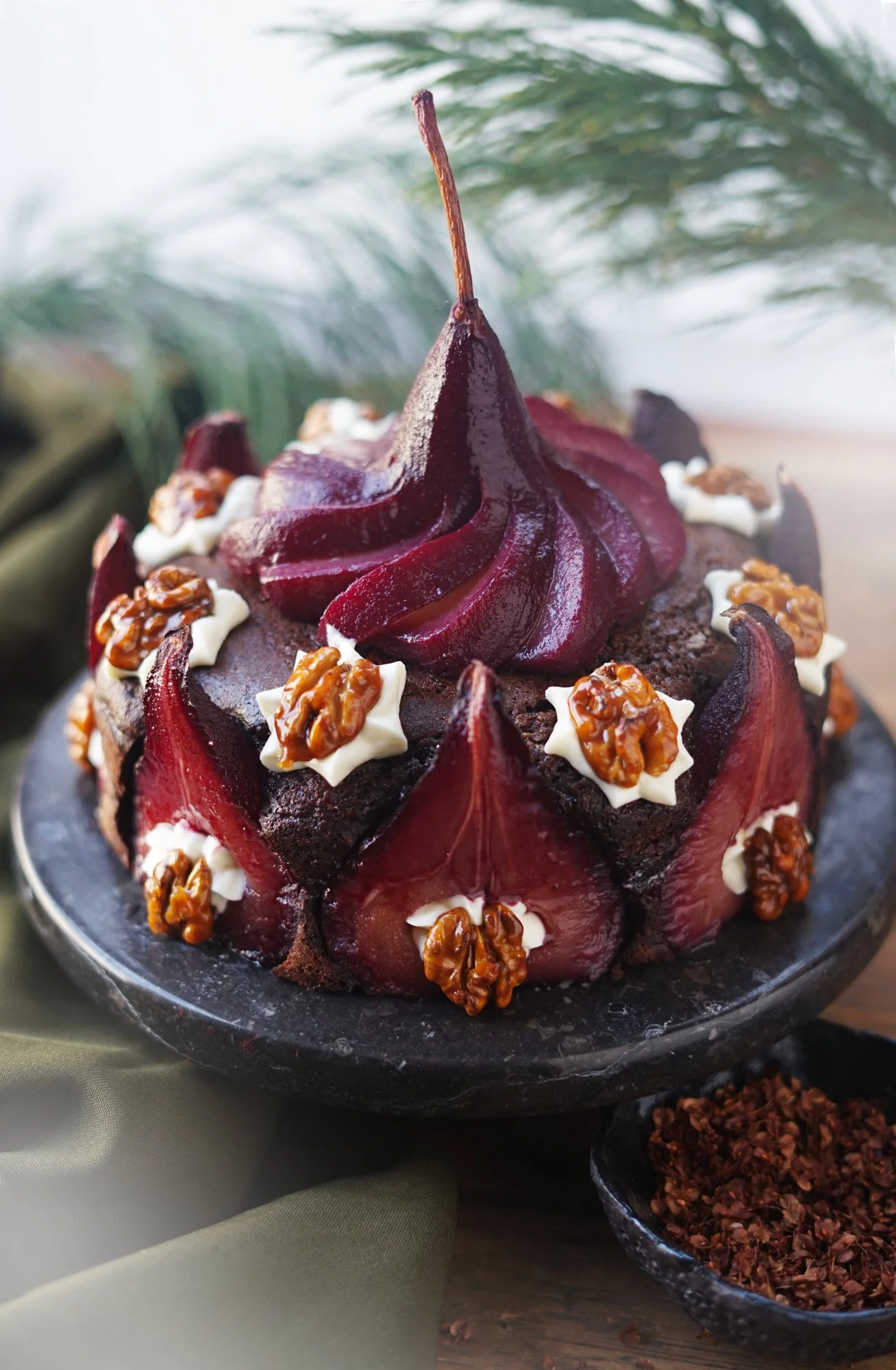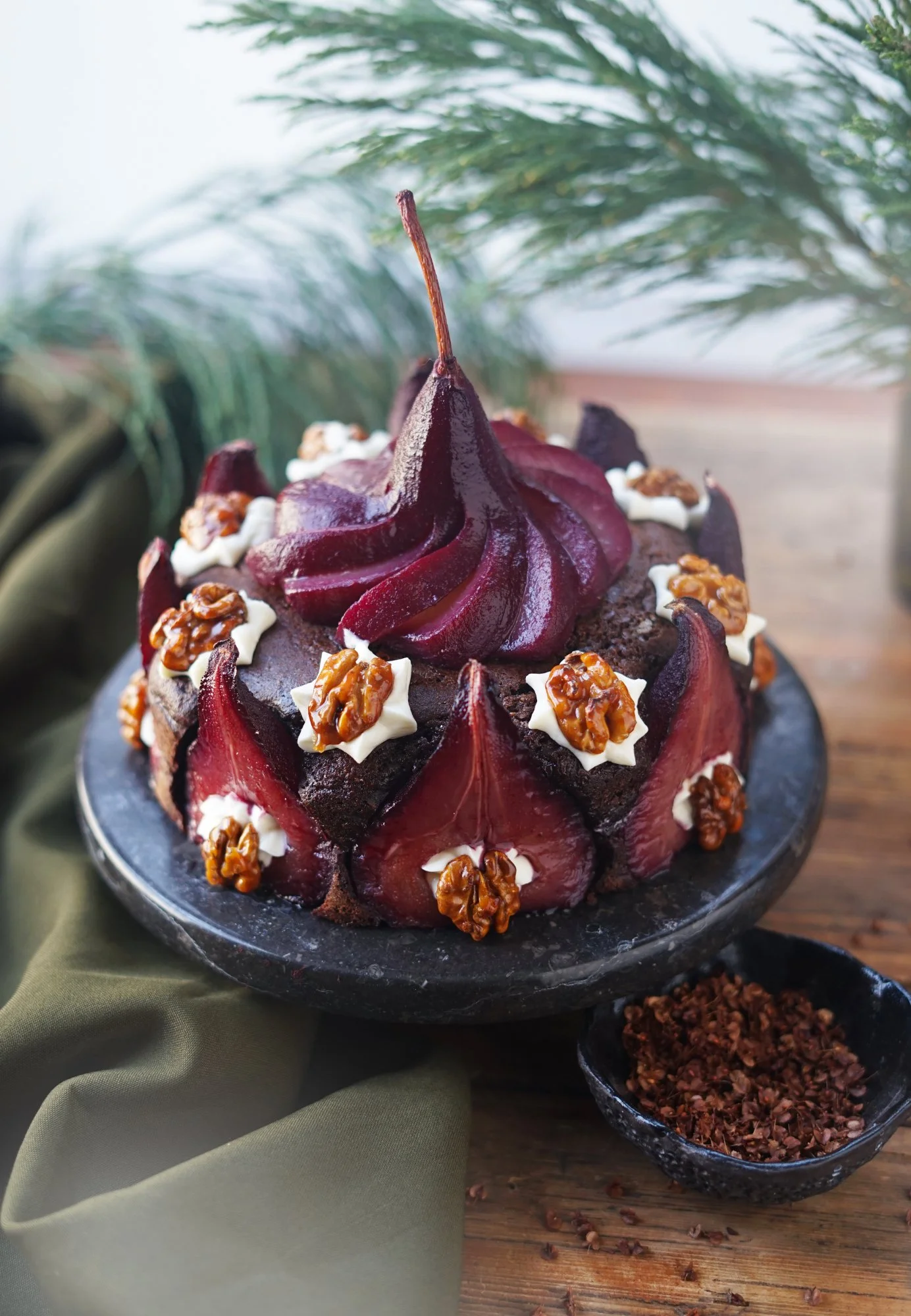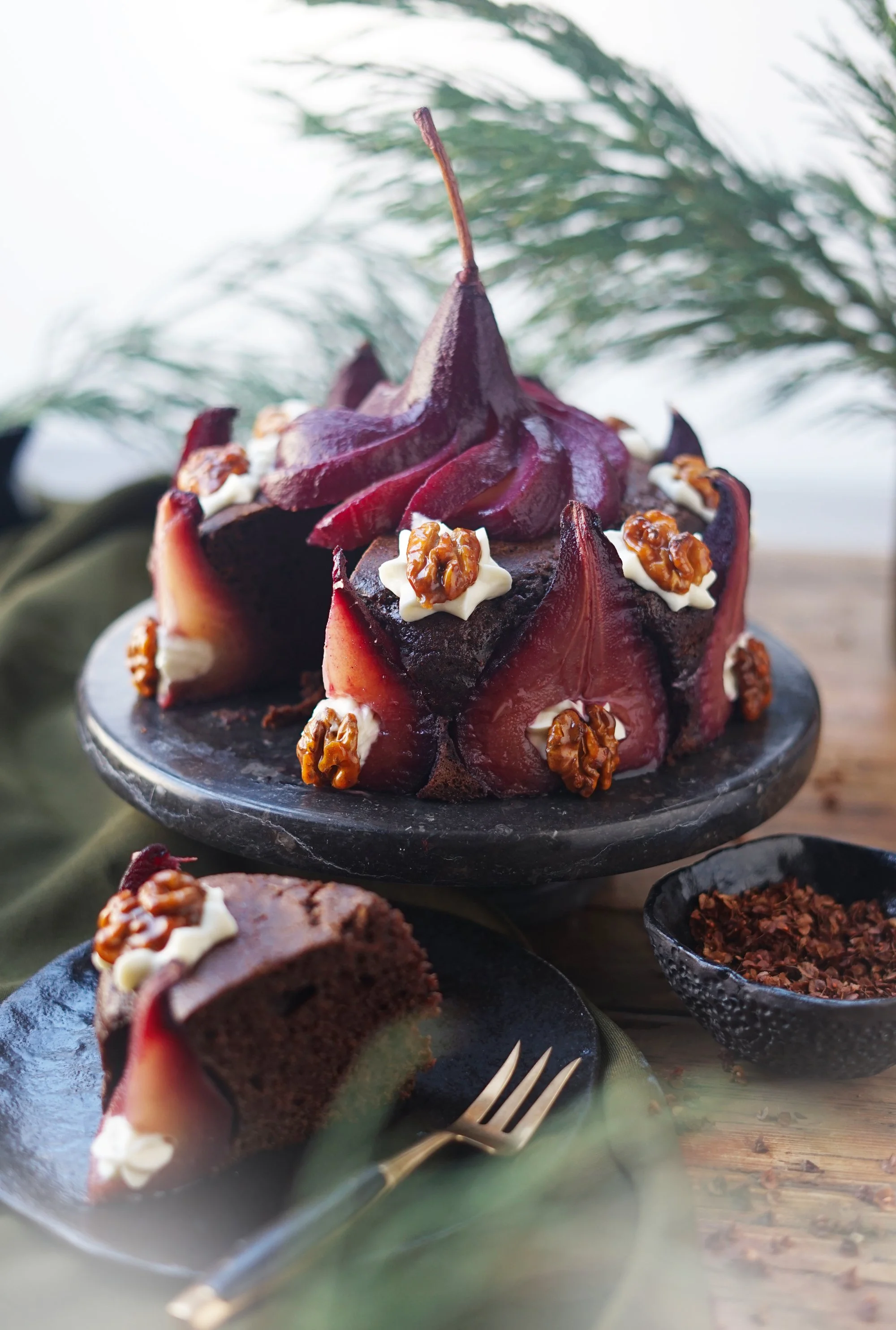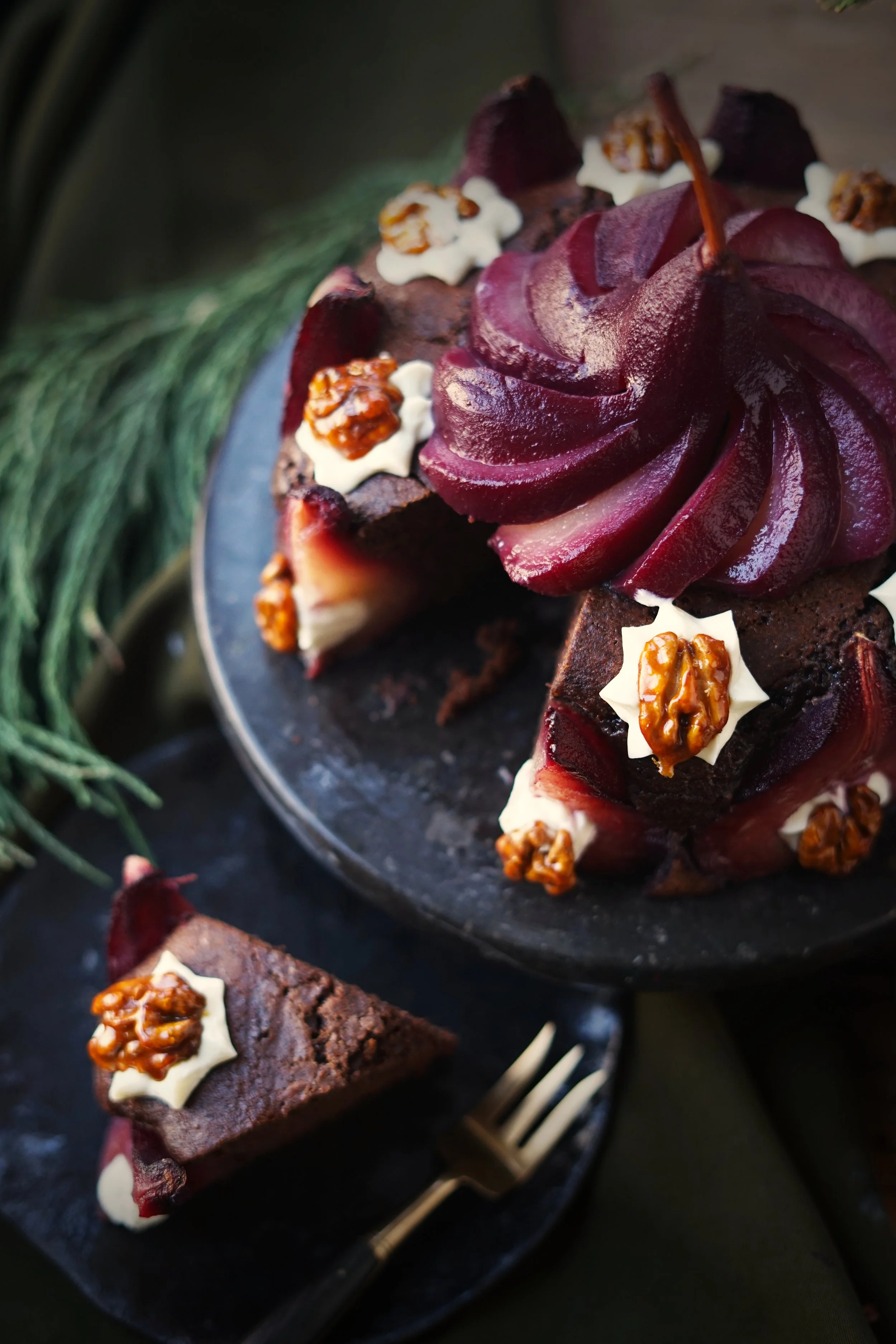Cake Dreams, Connection, And Curly Dock Magic
New to foraging? Learn more about ethical and safe foraging (plus how to get started) here!
This cake appeared to me in a dream. After a day of gathering and processing the rusty spires of curly dock seeds that stand out against the golden foothills, I went to bed with the toasty warm fragrance still in my nose, and my brain presented me with the gift of inspiration as I slept.
The first part of my dream was a blur of gold, of threads stretching across distances, anchored in my chest. It was blurry and surreal, and then at some point it shifted to a more tactile vision of mixing batter. I woke up with a clear vision of the finished cake and the memory of decorating it. I quickly scribbled down a sketch and a few descriptive words before it left me in the haze of the morning. Curly dock cake with mulled wine-poached pears, candied walnuts, and mascarpone cream. A crowned presentation. A luscious cake. “Add gold” instructed a sleepy scribble up the side of the page.
Curious, I looked up “cake dream meaning” and most of the dream interpretation sites I found said that cake dreams were about love. It makes sense - after all, a cake is the sign of a celebration, usually shared at a party or given as a gift. Many of the various sites said that cakes were a sign of the love and compassion the dreamer has for other people. I was touched by that, since I think of myself as someone who has a lot of love to share!
After all, connection is what drives nearly everything I do. I want to provide people with the tools to connect to their community, to connect with themselves, to connect with land they live in. I see a world blanketed by tiny little golden threads, connecting each of us, anchoring us to our surroundings, crossing oceans, bridging gaps much wider than even that. The world I see is shimmering with those lovely little threads, which carry a universal truth: we are all connected. It can be difficult to grasp that feeling, however, when one feels the weight of the world.
Amidst the pain and conflict, the sad news headlines and changing climates, it can feel difficult not to get sucked up in a tide of remorse, particularly about things we cannot control. It seems as though our natural human response to this predicament is to close up and start seeing the world as “other.” This beautiful passage from a newsletter written by Rebecca Altman of Kings Road Apothecary explains this perfectly:
“But underneath all of these things that are happening, there is so much ‘other’ing. The people who commit atrocities see the people, communities or ecosystems that they harm as ‘other’. We (as a whole, though there are plenty of us individuals who don't) see the earth as other. Our ecosystems as other. Things outside of us. Things that aren’t actually a part of us. We see a country on the opposite end of the world as ‘other’, not an extension of ourselves, or an extension of all of us. And in hardening ourselves to what’s happening, casting blame, allowing ourselves to be incited to hatred, we then do the exact same thing that causes the problem in the first place. It is easy to ‘other’ because we do not want to see another person’s pain, or to feel our own. It is easier to call people names than to see them as human, and to see them as an extension of us, and us as an extension of them. We ‘other’ because we don’t want to face ourselves. The louder the voice of othering, the deeper the fear that we are what we hate.”
This is what I think of when I read about wars in our history books, which paint us as “the good guys” even though we have done some terrible things. History is written by the victor, after all. As he so often did, Terry Pratchett had some insight into the human condition regarding ‘othering’:
“It was so much easier to blame it on Them. It was bleakly depressing to think that They were Us. If it was Them, then nothing was anyone’s fault. If it was Us, what did that make Me? After all, I’m one of Us. I must be. I’ve certainly never thought of myself as one of Them. No one ever thinks of themselves as one of Them. We’re always one of Us. It’s Them that do the bad things.” -- Jingo, by Terry Pratchett
It’s always Them that do the bad things... Except when it’s not. It is a disheartening time in my country right now. Our society feels more divisive than ever. We have broken ourselves up into sects of “other,” slashing at those golden threads in an attempt to protect ourselves from becoming what we fear. It’s a short leap from fear to anger. “The louder the voice of othering, the deeper the fear that we are what we hate.” It breaks my heart to see so many threads chopped, to hear cruelties lobbed at asylum seekers and refugees, other humans just looking for a safe place to fall.
What begins with racial slurs and derogatory jokes ends in seeing other people as less than human, and therefore acceptable to brush off, hurt, or abandon. It is to close the doors to empathy and connection to prevent our own hearts from breaking. But the effect of “othering” so determidly and aggressively is to close ourselves off to the beauty of connection in all aspects of our life. Sometimes I wonder how so many people in my country can show such cruelty to other people just looking for a safe place to start over. Poet Nayyirah Waheed expressed those feelings in a perfectly poignant poem:
“you broke the ocean in
half to be here.
only to meet nothing that wants you.
--immigrant”
That dream about this cake was about more than just cake. It was about mending that web of golden threads. It was about opening to others once again. It was about understanding that staying open may bring pain, but it will be balanced by the floodgates of light and warmth that accompany a kind gesture. It’s amazing how far a little kindness (or a piece of cake) can take you! Repairing that golden web is how to come back to a place of deep connection. Think of the families that are new to your area, the people who left everything familiar and comfortable behind. Cake is a symbol that everyone understands. “Welcome, I’m glad you are here” is a message that accompanies it without any need for words. Folding a little bit of the landscape into the batter can be seen as a touch of magic, a way to help newcomers engage with their new home.
This time of year it is especially important to watch out for those who may be feeling isolated. The holiday season can be difficult for so many. Some may feel excluded from holiday celebrations because of their faith. Others may feel homesick for the way they used to celebrate in a home that no longer exists for them. Still more feel the grief of their losses during times full of significance and ritual. That empty chair at the family table is a somber reminder on days usually filled with joy. Pay attention to the people that don’t show up. Pay attention to the people that haven’t found their place yet. Open your heart to feel out who needs a reminder that they are loved and welcome. Bake them a cake.
And if you sense that someone is hungry for a deeper connection, take them out into the wild with you. Show them the gems hidden in our landscape, that so many little wonders can be found even in the bleak days of winter. Teach them the foods that taste of their new home. Foraging has taught me so much about connection. I no longer feel like winter is barren; it may be more difficult to find wild edibles now, but there are treasures hidden out there and finding them feels like a wonderful adventure. Even taking people who were born and raised here out into the landscape to find deeper connection fills me with warmth. I see my friends becoming more patient with the pace of the seasons and with their own pace as well. I see them slow down in the winter, settle in, enjoy the wonders that they’d never noticed before.
I truly believe that my love for connecting with others comes directly from my relationship to the landscape. Those golden threads keep me tethered to the wild and the wonders it hides. I become what I eat: wild, free, and part of the landscape. What a perfectly beautiful experience to share with others - especially those who have been “othered” by so many.
The rusty spires of curly dock are a symbol of fertility in many cultures throughout history. It’s easy to understand why, as each stalk is just dripping with seeds! It’s one of the easiest sources of wild flour I know of. I simply harvest the plentiful stalks, give them a wash (if needed), then lay them out to dry. Then I roast the dried seeds, husks and all, in my oven at 350F for a few minutes until they are fragrant, dry, and toasted. I grind them into flour in small batches using my electric spice grinder. Soon, I have lots of flavorful flour packed with fiber, protein, and the taste of our winter landscape. As I work with this plentiful plant, a feeling of bounty comes over me. There is plenty to share. My cup is full. I have plenty of love and compassion to spread, and I know that rather than running dry, such connection will lead to an even fuller cup. How will you cultivate warmth in the cold of winter? How will you spread light on the darkest nights? What is your bounty to share?
This cake is in honor of the lessons of curly dock, that the land is plentiful even when it appears barren. It reminds me to share, especially with those feeling isolated and un-rooted. It is a golden thread to me, my community, my landscape. Sometimes a cake can be so much more than just a cake. Better make it special, then. And add gold, as instructed by my sleepy scribble.
Curly Dock Cake with Mulled Wine Poached Pears
This regal cake is perfect for the holiday season. Hearty curly dock flour gives a rich nutty flavor to this cake, which is perfectly offset by soft poached pears colored a sumptuous garnet red. Candied walnuts and whisky-mascarpone frosting finish the beautiful presentation. Plan ahead, since your pears will be best if they bathe overnight in the rich spices of mulled wine.
Cake Ingredients:
6 firm but ripe bosc pears
1.5 L mulled wine
½ c. sugar
1 vanilla bean, cut in half
1 c. all-purpose flour (or gluten-free baking mix)
1/2 c. curly dock seed flour
1 ½ tsp. baking powder
¼ tsp. Ground cardamom
¼ tsp. Ground nutmeg
1/2 tsp. salt
1/2 c unsalted butter, at room temperature
¾ c. granulated sugar
3 medium eggs, at room temperature
2 tsp. vanilla extract
2 Tbs. whiskey
1/2 c. yogurt
Directions:
Combine the mulled wine, sugar, and vanilla in a medium saucepan. Bring to a boil, then reduce to a simmer while you prepare your pears.
Gently peel the pears by using long strokes of the vegetable peeler or knife. Leave the stems intact. Cut a bit off of the bottom of each one so they can stand up straight. Set aside and cut a circle of parchment paper just smaller than the the top of your saucepan, with an x in the middle for steam.
Gently lower the pears into the wine mixture and cover with the parchment paper.
Simmer the pears for 1 hour, gently turning them with a spoon often so they take on the color evenly. Remove from heat and cool to room temperature, continuing to turn the pears every 20 minutes or so. Once the mixture has cooled to room temperature, you can either prepare the cake now, or refrigerate the pears in their poaching liquid overnight to give them a deeper color. (If you do, just be sure to turn them a couple of times like right before you go to bed and as soon as you wake up.)
Remove the pears from the poaching liquid and keep covered. Re-heat the liquid and simmer until it has reduced to a syrup. Meanwhile, cut four pears in half and use a melon baller to scoop out the cores.
Now, bake the cake: Preheat the oven to 350F. Grease an 8” springform baking pan. Place a parchment circle on the bottom and line the sides with a parchment rectangle that extends up the sides about 6”. Grease again.
In a small bowl, whisk together the flours, baking powder, spices, and salt. Set aside.
In a large bowl, beat the butter until creamy, then gradually add the sugar and beat until light and fluffy (about 5 minutes.) Keep beating and add the eggs, one at a time, beating well after each addition. Add the vanilla and whisky.
Add the dry ingredients in 3 additions, alternating with the yogurt (beginning and ending with dry ingredients.) Beat just until combined after each addition - do not overmix.
Pat the poached pear halves dry. Press them into the cake tin, cut sides against the walls, evenly spaced around the outside. Reserve the extra pears for decoration after baking. Scoop the batter into the cake pan, being careful not to dislodge the pear slices.
Bake the cake until the top has slightly browned and a toothpick inserted into the center comes out clean, about 50-55 minutes. Cool in the pan on a cooling rack for at least 20 minutes, then very gently remove the springform walls and parchment paper to reveal the cut pear slices.
To assemble:
1 c. mascarpone or cream cheese, at room temperature
1/4 c. honey or maple syrup
2 Tbs. whiskey
roasted or candied walnut halves*
reserved wine syrup
leftover poached pears
Directions:
Once cake has cooled completely, whip together the mascarpone, honey, and whiskey to form a smooth mixture. Scoop this into a piping bag with a star tip.
Cut a leftover poached pear into slices, leaving the top intact. Swirl into a fan shape on top of the cake. Brush it and the slices on the side of the cake with the reserved wine syrup to give them a shine.
Pipe some icing into the hole on each pear and press a walnut in place. Use the icing to decorate the top of the cake as well.
*To make easy candied walnuts, add 1 cup whole walnut halves, ¼ c. honey, 1 Tbs. unsalted butter, and ⅛ tsp. Salt to a non-stick skillet. Cook over high heat, stirring often, until the moisture evaporates and the nuts get slightly darker, glossy, and start to clump together. (Be careful not to overcook!) Immediately spread the nuts onto a sheet of parchment paper or a non-stick mat. (Keep in mind that they’ll be very hot at this stage, so avoid touching them with your fingers!) Let cool completely, then break the walnuts apart.
Love what you’ve read here? Don’t forget to Subscribe to get frequent updates of new posts!
Huge thanks to my Patrons that make sharing all of these lovely posts with you possible (without all of the pop-ups and ads that make browsing other blogs so annoying). If you’re feeling generous, you too can support the wonder with a monthly contribution of your choice. Even $1 helps a lot! Your donation will help to fund this blog as well as my surprise free events and gifts for strangers. Learn more about this program at the link below:




















Join me for a little winter night magic as we bake this cake full of rich seasonal flavors and black cocoa!